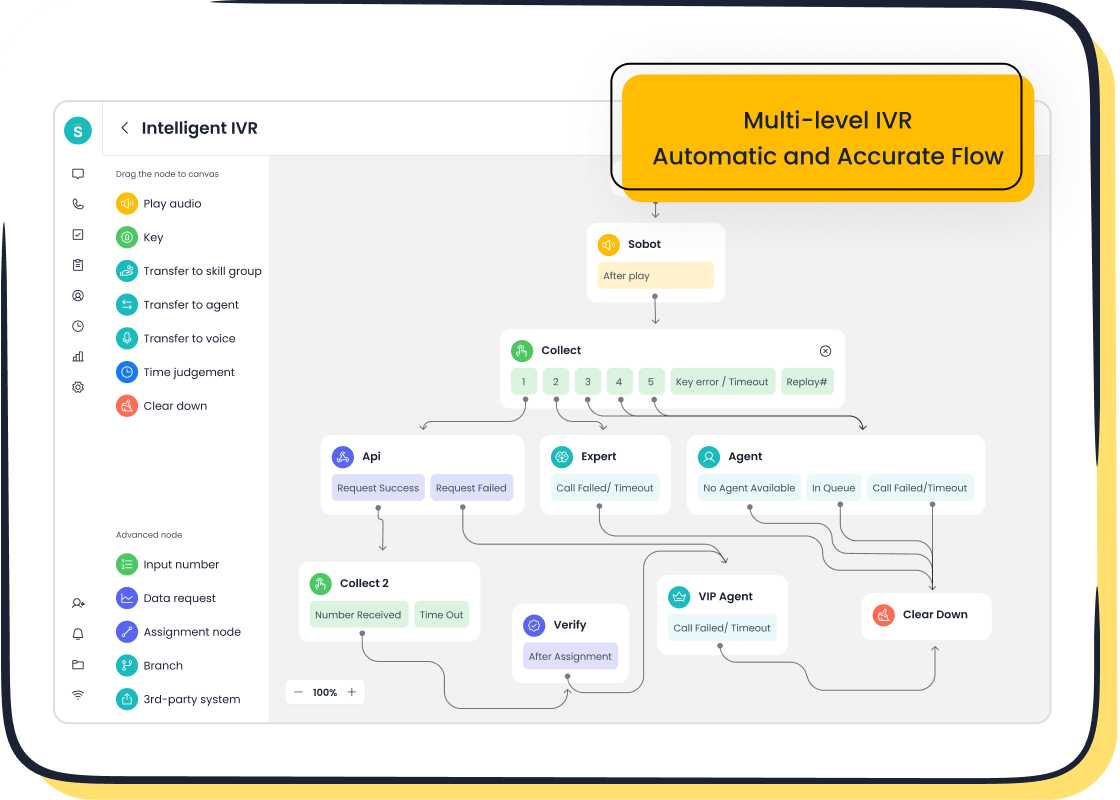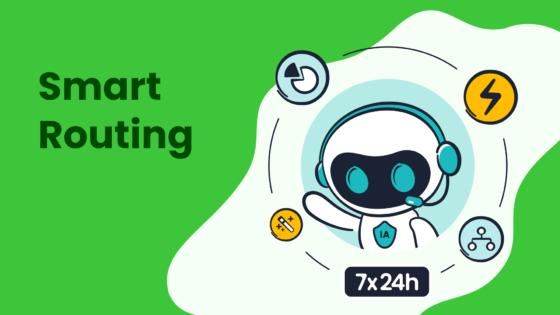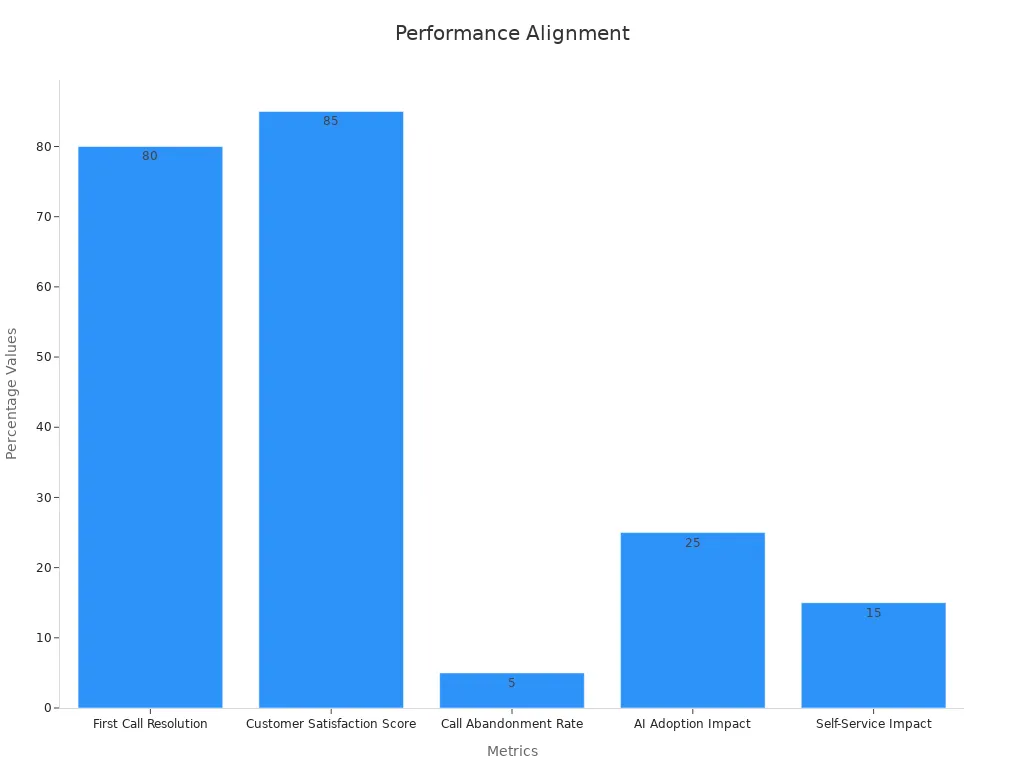Cloud-Based Contact Centers Explained for Businesses

A cloud-based contact center is a customer service platform hosted on the internet, enabling businesses to manage interactions without relying on physical infrastructure. It serves as a crucial solution for contact centre providers, delivering seamless support across multiple channels such as calls, emails, and chats, ensuring customers receive quick and efficient assistance.
The demand for cloud contact centers continues to grow rapidly. In 2023, the global Contact Center as a Service (CCaaS) market reached $5.5 billion, with projections estimating $23.6 billion by 2032. Businesses are increasingly adopting these solutions to meet customer expectations, with 66% of new companies accelerating their migration to cloud-based platforms. Contact centre providers like Sobot offer innovative tools that help businesses stay competitive while enhancing customer satisfaction.
What Is a Cloud-Based Contact Center?

Definition and Core Concept
A cloud-based contact center is a modern customer service platform hosted on the internet. Unlike traditional systems that rely on physical infrastructure, this cloud-based solution operates entirely online. It allows businesses to manage customer interactions across multiple channels, including voice, email, SMS, and social media, from a single platform.
Key Features of a Cloud-Based Contact Center:
- Internet-hosted service managed by a third party.
- Eliminates the need for on-premise hardware and software.
- Supports remote work and scalable infrastructure.
- Enhances customer experience with advanced tools.
For example, a cloud contact center provides call routing, reporting, and support for digital channels. This flexibility ensures that your team can deliver seamless service from anywhere with an internet connection.
| Feature/Benefit | Description |
|---|---|
| Internet-hosted service | A cloud contact center is managed by a third party and handles all customer communications. |
| Cost-effectiveness | Eliminates the need for on-premises software, hardware, and infrastructure. |
| Core functionality | Includes call routing, reporting, and support for digital channels like email and text messages. |
| Flexibility | Enables remote work and scalable infrastructure without on-premises requirements. |
| Enhanced customer experience | Provides easy access to technology for better customer service. |
Why Businesses Are Adopting Cloud Contact Centers
Businesses are rapidly adopting cloud contact center solutions to meet evolving customer expectations. These platforms offer speed, flexibility, and cost efficiency, making them an ideal choice for modern organizations.
Here are some reasons why businesses are making the switch:
- Speed of Deployment: Cloud contact centers can be set up quickly, reducing downtime.
- Enhanced Data Security: Advanced encryption ensures customer data remains safe.
- Flexibility in Operations: Agents can work remotely, improving productivity.
- Improved Customer Experience: Seamless service across multiple channels boosts satisfaction.
- Cost Efficiency: Eliminates the need for expensive hardware and reduces maintenance costs.
A study shows that customer preferences for digital channels have increased significantly. Many users now favor self-service options, which cloud contact centers can provide effectively. Businesses that adopt these solutions often see improvements in customer satisfaction and operational efficiency.
| Metric | Improvement |
|---|---|
| Net Promoter Score® | 149% increase |
| Post-call survey score | 96% increase |
| First-call resolution rate | 93% increase |
| Inbound calls handled by self-serve IVR | 8% |
| Callback take rate | 8% increase |
| Survey take rate | 2% increase |
| Abandon rate | 55% decrease |
| Average speed to answer | 64% decrease |
| SLA | 28% increase |
| Processing time for claims | 10 days decrease |
| Call transfers | 69% reduction |
| Revenue | 18% increase |
| Employee engagement | 8% increase |
| Business continuity during COVID-19 | Minimal disruption |
Key Differences from Traditional Contact Centers
Cloud-based contact centers differ significantly from traditional systems. These differences make them a more attractive option for businesses looking to modernize their customer service operations.
| Feature | Cloud-Based Call Centers | Traditional Call Centers |
|---|---|---|
| Scalability | Easy scalability based on call volumes | Limited scalability requiring significant investment |
| Cost Savings | Eliminates need for expensive hardware | Higher maintenance and modernization costs |
| Flexibility | Agents can work from anywhere | Agents are tied to physical workstations |
| Deployment | Quick and easy setup | Time-consuming and costly to scale |
| Disaster Recovery | Built-in redundancy and backup capabilities | Offline functionality during internet outages |
| Control | Less physical control over infrastructure | Complete control over infrastructure |
| Data Security | Concerns about storing data on cloud servers | More control over sensitive data |
| Customer Experience | Advanced features improve service | Established processes ensure consistency |
Cloud contact centers provide scalability, flexibility, and cost savings that traditional systems cannot match. For example, agents can work from anywhere, and businesses can scale operations without investing in additional hardware. These advantages make cloud contact centers a preferred choice for companies aiming to enhance customer service while reducing costs.
How Does a Cloud-Based Contact Center Work?
The Role of Cloud Technology in Operations
Cloud technology forms the backbone of a cloud contact center platform. It eliminates the need for physical infrastructure by hosting all operations on the internet. This setup allows you to manage customer interactions seamlessly while reducing costs and improving efficiency.
Key features of cloud-based contact centers include:
| Feature | Description |
|---|---|
| Cloud infrastructure | Managed by the service provider, eliminating the need for on-premise hardware and software. |
| Omnichannel routing | Automatically directs inquiries to the right agent based on various factors for improved efficiency. |
| Interactive voice response | An automated system that assists callers and directs them appropriately. |
| Call recording and monitoring | Enables supervisors to ensure quality and provide training through call reviews. |
| Real-time analytics | Offers insights into performance metrics and customer interactions for operational optimization. |
| VoIP technology | Utilizes internet-based communication instead of traditional telecom hardware. |
| CRM integration | Syncs communication data across platforms for a seamless customer experience. |
For example, a North American airline transitioned its call center to the cloud using Amazon Connect on AWS. The move replaced an unstable legacy IVR system, improving operational efficiency and customer experience through better audio quality and scalability.
Cloud contact centers also offer scalability and flexibility. You can easily adjust the number of agents based on call volume, ensuring optimal resource use. Additionally, these platforms provide robust disaster recovery options, enabling you to resume operations quickly after disruptions.
Managing Customer Interactions Across Channels
A cloud contact center platform enables you to manage customer interactions across multiple channels, such as voice, email, SMS, and social media. This omnichannel approach ensures that customers can reach you through their preferred communication method, enhancing their experience.
Performance metrics play a crucial role in managing these interactions effectively.
| Metric Type | Description |
|---|---|
| Customer Satisfaction | Measures customer satisfaction through CSAT, NPS, and CES, providing insights into customer experience. |
| Agent Performance | Includes AHT, FCR, and call quality monitoring to evaluate agent efficiency and service quality. |
| Channel Performance | Tracks channel utilization rates and average resolution times to optimize workflows across channels. |
| Agent Productivity | Assesses the number of interactions handled and adherence rates to improve agent efficiency. |
| Quality Assurance Metrics | Involves reviewing call recordings and written communications to ensure quality and compliance. |
| Compliance and Security | Monitors adherence to regulations and security protocols to protect customer data. |
For instance, Sobot's omnichannel solution integrates AI-driven automation to handle repetitive queries, freeing agents to focus on complex issues. This approach improves productivity by 30% and enhances customer satisfaction. By consolidating customer data into a unified workspace, you can deliver personalized and efficient service across all channels.

Integration with Tools Like Sobot Voice/Call Center
Integrating tools like Sobot Voice/Call Center into your cloud contact center platform can significantly enhance its capabilities. Sobot's solution offers features such as intelligent IVR, smart call routing, and real-time analytics, enabling you to manage customer interactions more effectively.
| Case Study Description | Key Outcomes |
|---|---|
| Reduced inbound discussion volume by 20% and increased positive feedback to 96% | Improved customer service efficiency |
| Streamlined experiences across front agent, back office, and branches | Cost-effective access to channels |
| Over 80% correct answers and 95% customer satisfaction | Enhanced service quality for VIP customers |
| 22.2% of customer questions answered independently, CSAT score of 97% | Fast, personalized service in Southeast Asia |
| 85% of problems solved, 99% customer happiness | Stable and responsive solutions |
| Sign-off rate increased by 35%, COD collection rate up by 40% | Improved communication and operational effectiveness |
Sobot Voice/Call Center also supports global telephony contacts and offers a 99.99% uptime, ensuring reliable operations. Its AI-powered voicebot enhances customer interactions by recognizing intent and providing intelligent responses. With seamless CRM integration, you can sync communication data across platforms, creating a unified customer experience.
By leveraging tools like Sobot Voice/Call Center, you can streamline operations, improve agent productivity, and deliver exceptional service to your customers.
Key Features of Cloud-Based Contact Centers
Omnichannel Communication and Unified Workspaces
A cloud-based contact center enables you to manage customer interactions across multiple channels, such as voice, email, SMS, and social media, from a single platform. This omnichannel approach ensures consistent service and improves customer satisfaction. With a unified workspace, your agents can access all customer data in one place, making it easier to provide personalized support.
💡 Did You Know?
Omnichannel customer support improves agent efficiency by streamlining workflows and providing real-time data access. This allows your team to handle queries faster and more effectively.
| Metric | Description |
|---|---|
| Unified Dashboard | Monitor interactions across all channels for valuable insights. |
| Real-Time Data Access | Empower managers to make informed decisions with up-to-date performance metrics. |
| Customer Satisfaction | Deliver consistent service across channels to enhance customer experience. |
By integrating tools like Sobot's omnichannel customer communication solution, you can unify your operations and improve both agent productivity and customer satisfaction.
Scalability and Flexibility for Growing Businesses
Cloud contact center software offers unmatched scalability and flexibility, making it ideal for businesses experiencing growth or seasonal fluctuations. You can easily add or remove agents based on call volume, ensuring optimal resource allocation without overextending your budget.
| Statistic | Description |
|---|---|
| 82% | Businesses cite scalability as a primary advantage of outsourcing. |
| 300-400% | Retail businesses experience call volume variations between peak seasons. |
| 40-60% | Faster scaling of new agents compared to in-house centers. |
This flexibility allows you to adapt quickly to changing demands. For example, AI-powered appointment booking bots can handle a 35% increase in volume during peak periods. With variable pricing models, you only pay for what you use, making cloud-based solutions cost-effective for businesses of all sizes.
AI and Automation Capabilities
AI and automation are transforming the way contact centers operate. These technologies streamline repetitive tasks, such as call routing and scoring, freeing your agents to focus on complex customer issues. AI also enhances customer interactions by offering self-service options like appointment scheduling and bill payments.
📈 Key Insight:
The contact center software industry is growing rapidly due to innovations in AI and automation. By 2021, over half of call centers had adopted AI strategies.
| Key Insight | Description |
|---|---|
| Growth Trajectory | AI innovations drive the growth of cloud-based contact center software. |
| Continuous Enhancement | Vendors consistently update features to improve customer experiences. |
| Integration Focus | Seamless integration ensures optimal use of AI for better service quality. |
With tools like Sobot's AI-powered voicebot, you can automate processes, reduce response times, and deliver hyper-personalized customer experiences. This not only improves efficiency but also boosts customer satisfaction.
Advanced Analytics and Reporting
Advanced analytics and reporting transform how you manage customer interactions in a cloud-based contact center. These tools provide actionable insights that help you improve efficiency and enhance customer satisfaction. By analyzing data, you can identify trends, optimize resources, and make informed decisions.
💡 Key Insight:
Advanced analytics improve customer experience and employee retention while reducing costs through better resource allocation.
Here are some ways analytics benefit your operations:
- Data-driven decisions reveal shifts in call volume and customer behavior.
- Monitoring tools enhance agent performance through feedback and supervision.
- Resource optimization balances workforce availability with call volume.
| Metric | Description |
|---|---|
| First-call resolution (FCR) | Tracks the percentage of calls resolved on the first interaction, showcasing efficiency. |
| Customer satisfaction scores (CSAT) | Measures customer satisfaction, offering insights into agent performance. |
| Average handle time (AHT) | Evaluates the time taken to resolve inquiries, highlighting operational efficiency. |
For example, using analytics, you can reduce average handle time while increasing first-call resolution rates. This improves customer satisfaction and streamlines operations. Advanced reporting tools also allow you to monitor key performance indicators (KPIs) in real time, ensuring your team stays on track to meet goals.
Remote Accessibility for Teams
Remote accessibility empowers your agents to work from anywhere, ensuring flexibility and continuity in operations. Cloud-based contact centers make this possible by hosting systems online and providing mobile-friendly tools for workforce management.
Organizations that embrace remote work see significant benefits:
- 55% of UK contact centers identify homeworking as their top advantage.
- Agents working from home experience an 80% higher retention rate.
In today’s world, offering remote options is essential for attracting skilled agents. Without this flexibility, your business may struggle to compete.
- Cloud platforms enable agents to access systems from any location.
- Mobile apps allow agents to manage schedules and monitor performance remotely.
- Scalable solutions adapt quickly to changing business needs, ensuring seamless operations.
Remote accessibility also supports business continuity during disruptions. For example, during the pandemic, companies with remote-enabled contact centers maintained operations with minimal downtime. By adopting cloud technology, you can ensure your team remains productive and engaged, regardless of location.
Benefits of Cloud-Based Contact Centers Over Traditional Systems

Cost-Effectiveness and Reduced Maintenance
Cloud contact centers provide significant cost savings compared to traditional systems. They eliminate the need for expensive hardware and on-premise installations, reducing upfront investments. Businesses using cloud systems reported a 58% reduction in hardware costs in 2023, according to IDC. Additionally, ongoing maintenance costs are much lower since the service provider handles updates and technical support.
| Evidence Type | Description |
|---|---|
| Cost Reduction | A European financial institution reduced monthly costs by 13% by transitioning to a cloud environment. |
| Fixed Costs | Predictable expenses for power and cooling eliminate financial surprises. |
| Rack Space | Reduced rack space lowers power costs and supports sustainability goals. |
Cloud contact center pricing models are flexible, allowing you to pay only for what you use. This scalability makes them ideal for small businesses or organizations with fluctuating customer service needs. Moreover, these platforms deploy quickly and support multiple communication channels, ensuring seamless operations without additional costs.
💡 Tip: Transitioning to a cloud contact center can help your business save money while improving efficiency.
Enhanced Customer Experience and Satisfaction
Cloud contact centers enhance customer satisfaction by providing seamless, omnichannel support. Customers can interact with your business through their preferred channels, such as phone, chat, email, or social media. This flexibility improves accessibility and convenience, leading to higher satisfaction rates.
| Metric | Description |
|---|---|
| Customer Satisfaction Score (CSAT) | Measures how satisfied customers are with your service. |
| Net Promoter Score (NPS) | Gauges customer loyalty by asking how likely they are to recommend your service. |
| First Contact Resolution (FCR) | Tracks the percentage of issues resolved on the first interaction, showcasing efficiency. |
For example, customer service organizations using cloud contact centers often achieve higher FCR rates, reducing the need for follow-ups. This efficiency not only saves time but also builds trust with your customers. Additionally, advanced tools like AI-powered chatbots handle repetitive queries, allowing agents to focus on complex issues. This approach ensures faster resolutions and a more personalized experience.
Improved Team Collaboration and Productivity
Cloud contact centers foster better collaboration among your team members. These platforms integrate seamlessly with tools like CRM systems, enabling agents to access customer data in real time. Features such as unified workspaces and performance management tools improve communication and streamline workflows.
| Tool/Feature | Description |
|---|---|
| Real-Time Guidance | Provides agents with immediate insights to enhance customer interactions. |
| Feedback Management | Collects actionable insights to improve service quality. |
| Interactions Analytics | Identifies trends and evaluates agent performance for better outcomes. |
For instance, customer service organizations benefit from AI-driven insights that offer real-time coaching and personalized feedback. This boosts agent productivity and ensures consistent service quality. Remote accessibility further enhances collaboration by allowing agents to work from anywhere, ensuring uninterrupted operations even during disruptions.
📈 Insight: Businesses using cloud contact centers report a 30% improvement in agent productivity due to streamlined workflows and better tools.
Business Continuity and Disaster Recovery
Cloud-based contact centers provide robust solutions to ensure your business remains operational during unexpected disruptions. These platforms prioritize resilience and recovery, helping you minimize downtime and protect critical customer interactions.
💡 Key Insight:
A strong disaster recovery plan ensures your contact center can quickly bounce back from outages, cyber attacks, or misconfigurations.
Here’s how cloud-based contact centers support business continuity:
- Automated backups reduce the risk of data loss. Snapshot-based backups create real-time copies of your data, while incremental backups save storage space and improve recovery options.
- Built-in redundancy ensures operations continue even during hardware failures or network outages.
- Competitive service level agreements (SLAs) guarantee rapid recovery. Many providers offer recovery time objectives (RTO) of one hour and recovery point objectives (RPO) of 15 minutes.
Cloud systems also prepare for unexpected failures. Tested disaster recovery plans ensure your contact center infrastructure remains resilient under pressure. These features allow you to maintain customer trust and operational efficiency, even during challenging times.
Real-World Success Stories: Samsung and Sobot
Samsung’s collaboration with Sobot demonstrates the transformative power of cloud-based contact centers. Facing challenges with fragmented communication channels and data inefficiencies, Samsung adopted Sobot’s all-in-one solution to unify operations and enhance customer service.
📈 Results:
Samsung achieved a 97% customer satisfaction rate and improved agent efficiency by 30%.
Sobot’s platform integrated seamlessly with Samsung’s internal systems, such as ERP and ticketing tools. This allowed agents to access comprehensive customer histories, reducing repetitive interactions and improving service quality. VIP customers benefited from customized video support, further strengthening loyalty.
Samsung’s success highlights the value of cloud contact centers in delivering personalized, efficient service. By leveraging Sobot’s advanced tools, Samsung transformed its customer experience and set a benchmark for operational excellence.
How to Choose the Right Cloud-Based Contact Center Solution
Factors to Consider When Evaluating Contact Centre Providers
Choosing the right provider for your cloud contact center solution requires careful evaluation. You need to ensure the platform aligns with your business needs and delivers reliable performance. Here are key factors to consider:
| Key Factor | Description |
|---|---|
| Product or Service | Ensure the platform offers essential features like self-service management and reporting. |
| Overall Viability | Assess the provider's financial health and growth strategy to ensure long-term reliability. |
| Sales Execution/Pricing | Look for flexible pricing models that allow you to scale operations as needed. |
| Market Responsiveness/Record | Evaluate how well the provider adapts to market changes and customer demands. |
| Marketing Execution | A strong brand presence often indicates better support and innovation. |
| Customer Experience | Choose a provider with a reputation for delivering exceptional customer service. |
| Operations | Ensure the provider has experienced staff to support multiregional operations. |
By focusing on these factors, you can select a provider that meets your operational and strategic goals. For example, Sobot’s solutions stand out with their robust features, scalability, and proven success across industries like retail and financial services.
Questions to Ask Vendors About Cloud Contact Centers
When evaluating vendors, asking the right questions helps you understand their capabilities and ensures their solution fits your needs. Consider these questions:
- What features and functionality do you offer?
- Do you have customer references showcasing success in similar industries?
- Where are your service nodes located geographically?
- Is your platform hosted on a public, private, or hybrid cloud?
- How is your architecture deployed (multi-tenant or multi-instance)?
- Can the software scale up or down based on call center needs?
- How easy is it to add new users like agents or supervisors?
- What training and support do you provide for onboarding?
- How does the solution scale to support more data and users?
- How future-proof is your platform?
These questions help you gauge the vendor’s reliability and scalability. For instance, Sobot’s cloud contact center solution offers seamless scalability and robust training, ensuring smooth implementation and growth.
Aligning Solutions Like Sobot Voice/Call Center with Business Goals
Aligning your contact center solution with your business objectives ensures maximum ROI. Metrics like First Call Resolution (FCR) and Customer Satisfaction Score (CSAT) can guide your decision.
| Metric | Value/Insight |
|---|---|
| First Call Resolution (FCR) | Leading call centers achieve rates above 80%. |
| Average Handle Time (AHT) | High AHT indicates inefficiencies in processes. |
| Customer Satisfaction Score (CSAT) | Well-run centers maintain scores around 85%. |
| Call Abandonment Rate | Exceeding 5% indicates long wait times. |
| AI Adoption Impact | 25% reduction in average wait times. |
| Self-Service Impact | 15% reduction in call volume in financial services. |

Sobot Voice/Call Center aligns perfectly with these goals. Its intelligent IVR and AI-powered voicebot reduce wait times and improve FCR. By integrating Sobot’s solution, you can enhance customer satisfaction and streamline operations, ensuring your contact center supports your strategic objectives.
Ensuring Security, Scalability, and Support
When choosing a cloud-based contact center, you must prioritize security, scalability, and support. These factors ensure your business operates smoothly while protecting sensitive customer data.
Cloud platforms offer robust security measures to safeguard your operations. Encryption protects customer information during transmission, while regular audits identify vulnerabilities. These features help you comply with data privacy regulations and build trust with your customers. For example, Sobot’s solutions include encrypted data transfer and secure dialing, ensuring your communications remain private and protected.
Scalability is another key advantage of cloud-based systems. These platforms adapt to fluctuating call volumes, making them ideal for businesses with seasonal demands or rapid growth. Real-time resource allocation ensures your team maintains consistent service levels, even during peak hours. This flexibility allows you to scale up or down without investing in additional hardware or infrastructure.
Support plays a vital role in maintaining system reliability. Cloud providers like Sobot offer 99.99% uptime, minimizing downtime and ensuring your contact center remains operational whenever needed. Reliable support structures also include training, technical assistance, and regular updates, helping your team stay productive and efficient.
💡 Did You Know?
Businesses using cloud contact centers experience superior reliability and security, ensuring uninterrupted operations and customer satisfaction.
| Benefit | Description |
|---|---|
| Scalability | Cloud platforms can adapt to fluctuating call volumes and service expectations, crucial for DMVs. |
| Resource Allocation | Real-time resource allocation ensures consistent service levels during peak hours. |
| Uptime | Superior reliability minimizes downtime, ensuring systems are available whenever needed. |
| Security | Strong security measures, including encryption and regular audits, protect sensitive customer data. |
By focusing on these three pillars, you can ensure your contact center supports your business goals while delivering exceptional service to your customers.
Cloud contact centers redefine customer service by offering flexibility, scalability, and cost efficiency. These platforms eliminate the need for physical infrastructure, enabling businesses to manage interactions across multiple channels from anywhere. Features like AI-driven automation, omnichannel communication, and advanced analytics enhance both customer satisfaction and operational efficiency. For instance, omnichannel strategies can help retain 89% of consumers, highlighting their importance in modern contact centers.
Choosing the right solution is crucial for staying competitive. Sobot’s cloud contact center solutions stand out with their 96% CSAT and 78% NPS, reflecting strong customer approval. A luxury retailer even praised Sobot for resolving a feature request in just one day, showcasing its commitment to excellence. By adopting Sobot’s tools, you can streamline operations, improve customer experiences, and future-proof your business.
💡 Tip: Transitioning to a cloud contact center is a sound strategy, with 55% of executives endorsing this move for its technological advantages.
FAQ
What is the difference between a cloud-based contact center and a traditional one?
A cloud-based contact center operates online, eliminating the need for physical hardware. Traditional systems rely on on-premise infrastructure. Cloud solutions offer flexibility, scalability, and cost savings, while traditional setups require significant upfront investment and maintenance.
Tip: Cloud-based systems are ideal for businesses seeking remote accessibility and quick scalability.
How secure are cloud-based contact centers?
Cloud-based contact centers use advanced encryption and regular security audits to protect customer data. Providers like Sobot ensure compliance with global data privacy regulations, offering secure communication and encrypted data transfer.
💡 Did You Know? Sobot’s platform guarantees 99.99% uptime and secure dialing for peace of mind.
Can cloud contact centers handle high call volumes?
Yes, cloud contact centers scale easily to manage high call volumes. You can add or remove agents based on demand without additional hardware. This flexibility ensures smooth operations during peak periods.
| Benefit | Description |
|---|---|
| Scalability | Adjusts resources in real-time. |
| Cost Efficiency | Pay only for what you use. |
Do cloud contact centers support remote work?
Yes, cloud contact centers enable agents to work from anywhere with an internet connection. Tools like Sobot Voice/Call Center provide mobile compatibility, ensuring seamless operations for remote teams.
Note: Remote accessibility boosts agent retention and ensures business continuity during disruptions.
How quickly can I set up a cloud-based contact center?
Cloud-based contact centers deploy much faster than traditional systems. Providers like Sobot offer quick implementation, allowing you to start operations in days rather than weeks.
💡 Insight: Fast deployment minimizes downtime and ensures a smooth transition for your team.
See Also
Best Cloud Contact Center Services Reviewed for 2024
Discovering Leading Cloud Contact Centers for 2025
Best Reviewed Contact Center Solutions for 2024
